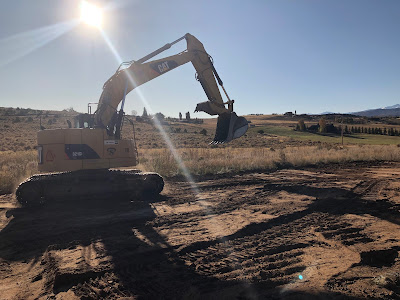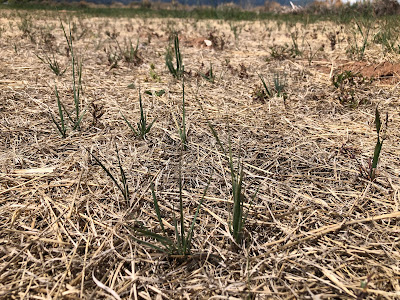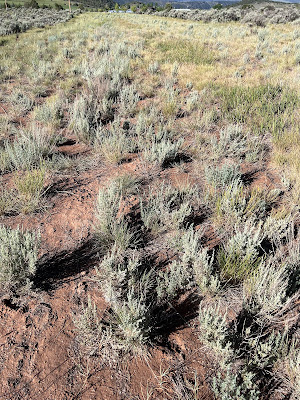In 2019 the local Natural Gas Company approached me with the news they would be placing a new pipeline through my property. They were putting in a 6" line to replace the current 4" line. They expected the job to last the summer and tear up a swath about 20' wide right through the center of the meadow. Now my meadow doesn't look like much since I have no water rights and no irrigation but it's enough for the cattle in the Spring to do some fire mitigation.
Around the House and... in the Meadow That green patch in between the sagebrush and the red barn is exactly where the gasline goes through. Not only would the pipeline nix grazing for that year but possibly several years after if the grass did not grow back after being pounded by heavy equipment for a summer. Would it come back from this in the promised "two years?" Without irrigation? Hmmmmmmmmmmmm....... So we made a deal- pay a bit more and use some of my land for a staging area and I'll use the cash to buy biochar compost. That way we could compare- same soil, same weather, same disturbance, but with two different rehab methods. The Gas Company would use their standard spray at the end of the job and I would put down their seed mix in biochar compost on the staging area. The Gas Company reclamation: Harrow the ground October 25 2019 spray green hay and seed (no idea if the green additive was fertilizer or preservative) By November 4 the "green" had faded November 6 the Staging Area is bare - no harrowing here Biochar compost on the Staging Area Load it into the spreader with the forklift (borrowed from nextdoor and with a great deal of help from Octavio and Scott) and add the same seed mix into the spreader... Spread it on the Staging Area Even it out a bit... Get some old moldy hay and spread that on top... (old and moldy so the elk don't think it's a Thanksgiving treat) The winter of 2019-20 was one of the driest I've seen since 1996 and the summer was even drier. There wasn't a whiffle of moisture all June and then came the Grizzly Creek fire to put a cherry ontop of COVID. The conditions were "challenging" March 24, 2020 and our "moisture" for the Spring. April 10, 2020 Pipeline: NO Biochar April 11, 2020 Staging Area : Biochar After a dusting of Snow on April 17... April 28, 2020 Pipeline NO Biochar April 28, 2020 Staging Area: Biochar May 30, 2020 Pipeline: NO Biochar May 30, 2020 Pipeline closeup NO Biochar May 30, 2020 Staging Area: Biochar May 30, 2020 Staging Area closeup: Biochar September 30. 2020 Pipeline NO Biochar September 30, 2020 Staging Area: Biochar April 12, 2021 Pipeline NO Biochar (even the skunk cabbage looks wilted) April 12, 2021 Staging Area: Biochar Two years gone. I complained- the Gas Company came back in 2021 with a water truck and spread more seed. The 2021-2022 winter was better than the previous winter. June 25, 2022 Pipeline NO Biochar June 25, 2022 Staging Area: Biochar Conclusion to date - 2020 was a major drought year and 2021 was better but still drought. This year 2022 seems about on track with 2021. The Biochar made a major difference in 2019-2020 and allowed grass to come back first before skunkweed and sagebrush. The pipeline reclamation may catch up if it keeps raining but it took 2 seedings and 3 waterings and there will be less grass and more sage than before even if there isn't bare ground. Bare ground in a drought goes hard as brick and doesn't let the water back in to feed the soil. The Biochar held what little water we had and gave it to the grass. Yes, one application of Biochar costs about 2X what the standard reclamation does- but if you have to come back an reapply the numbers even out and if what you get back is less suitable for grazing... well that's not optimal either. The cows haven't come back yet.Sunday, July 24, 2022
Subscribe to:
Post Comments (Atom)































4 comments:
One difference between your 2 plots is that the pipeline tract had a trench dug through it sifnificantly disturbing the soil web and layers.
When when 60" & 24" pipelines were put through my ranch, the soil disturbance was the biggest factor in the recovery of my field and native areas. The area that was trenched across the fields was good for a landing strip ever after. The native and steep slopes were worthless. I employed 'poop 'n stomp' to regenerate areas where possible.
By the way, the spuds you gave me are fantastic!
Hi Ziska, did the Utility have an easement through your land? What denaturalisation did they have to do? What was the cost of the Biochar? They are doing the same work on my land and they have a 60 wide easement. So they have the right.. just wonder if I have any leverage to have them the same to get it to grow back. Thanks Yo can mail me at Tobias.munk at me.com
Megan,
To be clear- 6" not 60" . The link to another biochar post showing the rehab process on Coal Creek outside of Redstone shows the Cattle stomp process.
I think the biggest factor in this was the persistent draught and a particularly bad year right after the pipeline. Biochar come back faster- and this is not the only instance where that has been the case. One year to regeneration even after 60 years of nothing (Hope Mine)
Tobius,
Yes all utilities have an easement. Yes, you can negotiate the contract to insure the best possible result for your property.
Biochar is about 2x (or more depending on shipping) the cost of the standard rehab and the Utility wasn't going to pay for it but by negotiating the price for the staging area. Because this is unirrigated land the cost of the staging area was more attractive than renting irrigated land. The end result was net zero $ to me but a much faster rehabilitation of the land.
I don't know if I'll ever get the grass back on the pipeline cut since the sage came back first.
Post a Comment